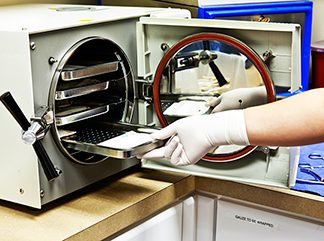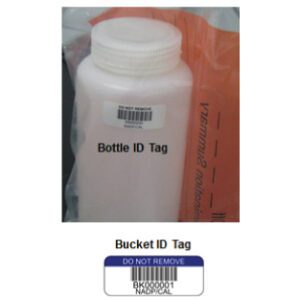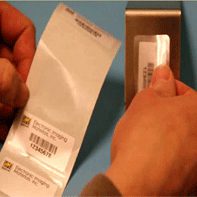Lab sterilization labels go through a lot!
SOLVENT CLEANERS
Of course, there will always be the need for traditional solvent cleaners like ethanol and isopropanol― diluted disinfectants that work on microbial cells but not spores. In most cases, however, deeper penetration is needed to eliminate contamination.
MOIST HEAT STERILIZATION (Autoclave)

Not to be overlooked, other heat sterilization methods include flaming or baking, incineration, boiling, tindalization, or simply using dry heat. Each method has specific applications and limitations.
As the popularity of plastics started to grow in the last century, more and more lab instruments were designed with these less expensive materials. Unfortunately, plastics really aren’t made to withstand rigorous heat sterilization and can only handle one or two sterilization procedures before they start to degrade. Disposable devices such as catheters and syringes that typically come in contact with blood or body fluids require multiple cycles of sterilization to ensure safety; as a result, labs have been forced to use low temperature sterilization methods.
CHEMICAL STERILIZATION
One low temperature process developed in the 1950’s is called EtO, a chemical sterilization based on using ethylene oxide gas. Ethylene oxide is utilized on medical and pharmaceutical products that incorporate electronic components, plastic packaging or plastic containers because it can penetrate not only devices but their packaging. EtO is an explosive and flammable mixture; so, while it is the least damaging method to use, its processing time is complicated with many steps to ensure security and safety―running anywhere from 6 to 24 hours. As a result, this method is rather expensive.

RADIATION
Other standard and popular sterilization methods use some form of electromagnetic radiation such as gamma rays, electron beams, X-rays or subatomic particles. They work especially well on DNA but there are differences between each method as to the amount of penetration and effectiveness:
- UV light is commonly used on surfaces and transparent objects (like glassware) and is fairly safe to use. Unfortunately, it can damage some plastics, does not work in shaded areas, and only hits a small area around a light source, so it is typically used on small items.
- Gamma rays are particularly powerful and work well during the manufacture of disposable items like needles, syringes, IV sets and food; it is also used to treat blood before transfusions.
- Electron beams tend to provide faster dosing rates than gamma radiation or x-rays so less exposure time is required and less degradation of polymers occurs. However, both gamma radiation and electron beams require shields to protect workers from exposure.
- X-rays, an electricity-based process that irradiates large packaging and pallets of medical devices, penetrate better than an electron beam process. X-rays are a bit more dangerous and require much more energy than other radiation processes, but neither x-rays nor gamma rays make materials radioactive.
STERILE FILTRATION
Sterile filtration is one more type of sterilization―commonly used on fluids that could be damaged by heat, irradiation or chemical processes. This method relies on a glass funnel or cellulose membrane filter to strain small microorganisms from liquids. It is popular for certain kinds of pharmaceutical and drug processing, but it is not the most reliable method.
*************
As a result of all these different types of sterilization processes, EIM looks at all the various levels of heat, moisture, chemicals, gases, irradiation, pressure and filtration in order to define the right label material for each application. Every method has distinct characteristics as do the different surfaces (glass, metal, plastic and more), so there is no “one-size-fits-all” label solution for all the special sterilization requirements. The key is the adhesive, but when you add other considerations such as exposure to chemicals or solvents, the parameters can change. Here is a short list of products that will meet some of those sterilization needs; there are certainly more from which to choose:
Autoclave: 340 White Polyester
EtO: CryoLabel® & XyResist® Plastics
Gamma Radiation: CryoLabel® Plastic
If you have a special process that needs lab sterilization labels, contact The Label Experts to discuss your application and get samples.




